
Why Teach Folk Songs? – Resources, How-to, and More
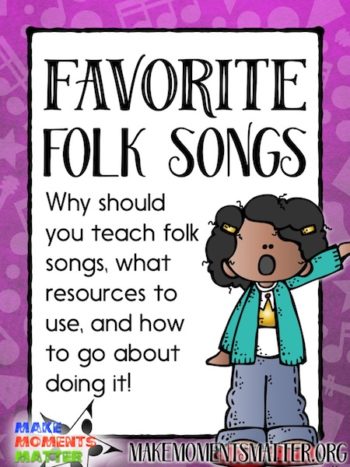 I remember when I first started teaching elementary music I spent my first few months teaching fun songs from the written textbooks that I had access to, favorite lessons from local music workshops, and memorable songs from my own childhood music classes. But then I hit a wall. When I started to “run out” of lessons and ideas I wasn’t sure where to turn for source material. Should I lean on the textbook series that I had access to (even though I didn’t really love the music or lessons)? Should I just keep asking friends for lesson plans that worked for them? What sort of songs should I teach!?
I remember when I first started teaching elementary music I spent my first few months teaching fun songs from the written textbooks that I had access to, favorite lessons from local music workshops, and memorable songs from my own childhood music classes. But then I hit a wall. When I started to “run out” of lessons and ideas I wasn’t sure where to turn for source material. Should I lean on the textbook series that I had access to (even though I didn’t really love the music or lessons)? Should I just keep asking friends for lesson plans that worked for them? What sort of songs should I teach!?
Everything changed when I started to use folk songs as the driving content in my classroom. Folk songs gave me endless source material to teach core content (all the state/national/district standards) and opportunities for extension activities. What’s more, the kids loved the folk song lessons because they were catch tunes, had fun games and dances, and really engaged them with their stories. I’ve been teaching folk songs ever since and haven’t looked back!
Why Teach Folk Songs?
Folk songs are wonderful musical creations that have stood the test of time and enchanted children and adults for hundreds of years. These songs endure because they are based on quality music and are easily adaptable to new situations (dances, games, etc.) When we sing folk songs it connects us with the generations who have come before us as well as other cultures from around the world. We follow in their footsteps and gather together because of our love for singing and dancing. What a beautiful legacy and what a wonderful culture to be a part of!
The melodies for most folk songs are interesting and catchy and, once learned, are great to go back later and use as the foundation for “piggyback” songs (where the melody stays the same but the words change). Folk songs are easily memorable and fun to sing unlike newly composed songs that were only written to teach a concept or prove a point. We’re not singing “sol mi, sol sol mi,” just because that’s an interval that we think should be emphasized. We’re singing the music for the music’s sake and “sol mi” is just a happy perk.
Folk songs are also great because they make it so easy to teach history and culture. In every lesson I take just a few minutes to explain little elements of the song and backstory to my students. Often folk songs use archaic or unusual vocabulary that students might not understand right away. Taking the time to explain the vocabulary helps grow kids schema and exposes them to new ways of thinking/communicating. Students also love learning about the history of songs. Kids marvel when they learn how old a song is and find out that people have danced and played and sung these songs for decades and even centuries.
More than a Melody – Why I Teach Historical Context
I’ve always loved folk songs, but I haven’t always loved how I’ve taught them. When I first started teaching I would use folk songs in my lessons but honestly I don’t think that I spent enough time talking about the history, the reasoning behind the song, and the cultural context. For example, I often taught the song “Lucy Locket” and the song and game were an instant hit. However, the students didn’t know anything about who Lucy was and/or why she lost that darned pocket! Lucy Locket was just a funny name and losing a pocket was silly. How could a pocket fall off your clothes?
That all changed a year or so ago. I started to really get into the history and context behind folk songs and made sure to do some research whenever I taught a new song so that I could add little tidbits of information or fun facts. I was able to tell my students the reasons for those funny word combinations and archaic vocabulary. I started to ask myself questions like “would a student know what this means?” and those questions began to drive my lesson plans. With a little research I could explain what it meant when the song talked about a specific place or situation. Students began to ask more questions and we really started to authentically connect what we were learning in class to history and other cultures.
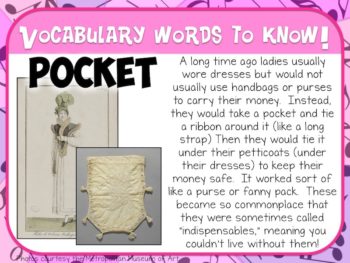 Let’s go back to the example of Lucy Locket. I only took a few minutes of my lesson time, but once I put some focus on teaching the context of the song I was easily able to expand the lesson and teach much more than just the music. I told students that scholars believe Lucy Locket and Kitty Fisher might have been real people who actually lived in London during the reign of Charles II. During that time women most often wore dresses but didn’t carry purses. This created a problem as they didn’t have a place to store their valuables. Ladies would take pockets of fabric and sew a long strap on them to use the pocket like a purse to store their money and valuables (either tying it under their skirts or wearing them on top of their clothes like a handbag). It is believed that Lucy Locket was a barmaid and didn’t make much money so when she lost her pocket it was sort of devastating for her. Kitty Fisher is believed to be a courtesan (she wouldn’t have to have paid for much on her own) and so for her, finding the pocket and taking the money inside was sort of a terrible thing to do. Lucy really needed it and Kitty did not!
Let’s go back to the example of Lucy Locket. I only took a few minutes of my lesson time, but once I put some focus on teaching the context of the song I was easily able to expand the lesson and teach much more than just the music. I told students that scholars believe Lucy Locket and Kitty Fisher might have been real people who actually lived in London during the reign of Charles II. During that time women most often wore dresses but didn’t carry purses. This created a problem as they didn’t have a place to store their valuables. Ladies would take pockets of fabric and sew a long strap on them to use the pocket like a purse to store their money and valuables (either tying it under their skirts or wearing them on top of their clothes like a handbag). It is believed that Lucy Locket was a barmaid and didn’t make much money so when she lost her pocket it was sort of devastating for her. Kitty Fisher is believed to be a courtesan (she wouldn’t have to have paid for much on her own) and so for her, finding the pocket and taking the money inside was sort of a terrible thing to do. Lucy really needed it and Kitty did not!
Conversations with kids about folk songs are important. Often in reflection about my own teaching I think that I don’t do enough to help students “understand the relationships between Music, the other Arts, and disciplines outside the Arts,” or to help them understand “music in relation to history and culture” (two of the “old” National Standards for Music Education). Folk songs give us an easy medium to make those connections in a quick and tangible way. When I started talking with my kiddos about folk song history and context I was able in just a few minutes to give them a backstory that was interesting and shed light on why we sang what we did. They understood who this person was and it made the song more real and the game more interesting. Since then I’ve started to have similar conversations with all of my students any time we teach a new folk song. I try and give a little context and shed some light on the people, places, and things behind the new folk song. Let me tell you, my students are way more engaged in the learning and they remember the song so much better.
Weird Words and Expanding Vocabulary – What is a Paw Paw?
I learned in my first few years of teaching that vocabulary building and creating a “text rich” environment were essential to help my students succeed. I obviously wanted students to learn music and have lots of fun, but I also wanted to help them develop their language and socials skills. I taught for many years in a building with a high population for English Language Learners and the information I learned about language acquisition and cognitive development was very influential in how I taught songs and daily lessons. It became abundantly clear that I needed to stop and talk about the lyrics instead of barreling along into the “fun stuff.”
 A great example of this was the song “Paw Paw Patch.” The first few times I taught this song I did so with echo singing, basically teaching the song by rote. As soon as we had the lyrics down I would go right into teaching an instrumental/accompaniment part or perhaps teach them the accompanying “play party” dance. The song went well and the kids LOVED the game, but a few days later one brave little girl asked me (while waiting for her bus) what a “paw paw” was. Clearly I had missed an opportunity.
A great example of this was the song “Paw Paw Patch.” The first few times I taught this song I did so with echo singing, basically teaching the song by rote. As soon as we had the lyrics down I would go right into teaching an instrumental/accompaniment part or perhaps teach them the accompanying “play party” dance. The song went well and the kids LOVED the game, but a few days later one brave little girl asked me (while waiting for her bus) what a “paw paw” was. Clearly I had missed an opportunity.
So I went online, did some research, downloaded photos, and came back to the class with this little 2 minute presentation. I talked about where the song came from and when it was first written down. We discussed the location of the Appalachian Mountains because at this point I taught in Kansas and the kids there knew very little about the Appalachians. Finally I showed them this slide about Paw paws and told them a little about the fruits. They were AMAZED! Soon “pickin up paw paws” to put in your pocket made much more sense to students. The game was changed, the song seemed brand new, and my kids had learned so much more!
Our “Favorite Folk Songs” – Resources for YOU
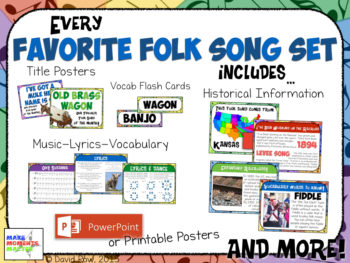 So as to help more people teach the history, context, and vocabulary behind folk songs I’ve created some resource kits for Teachers Pay Teachers called “Favorite Folk Song Teacher Kits.” Each set includes a header/title page poster, information about what region the folk song came from, historical and biographical information, any back story that I could dig up, history about publication, a printed melodic line, as many lyrics as I could find (that were appropriate for students), game or dance instructions if they exist, links to videos or media links (if available), and a few pictures and vocabulary flash cards. To learn more, look at the images below, check out the TpT page previews, or go download either of the FREE teacher kids for the songs “Alabama Gal!” or “Looby Loo.”
So as to help more people teach the history, context, and vocabulary behind folk songs I’ve created some resource kits for Teachers Pay Teachers called “Favorite Folk Song Teacher Kits.” Each set includes a header/title page poster, information about what region the folk song came from, historical and biographical information, any back story that I could dig up, history about publication, a printed melodic line, as many lyrics as I could find (that were appropriate for students), game or dance instructions if they exist, links to videos or media links (if available), and a few pictures and vocabulary flash cards. To learn more, look at the images below, check out the TpT page previews, or go download either of the FREE teacher kids for the songs “Alabama Gal!” or “Looby Loo.”
——————

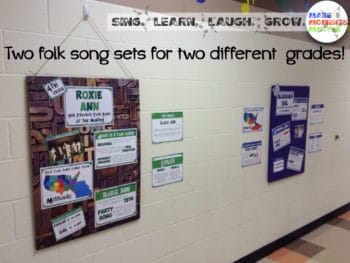



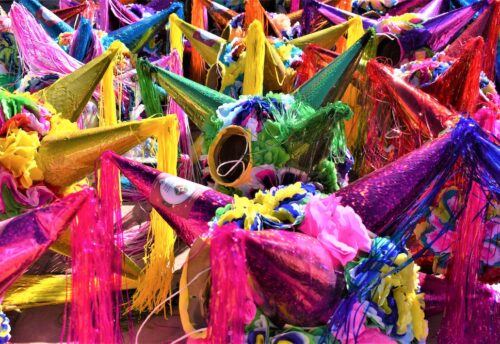
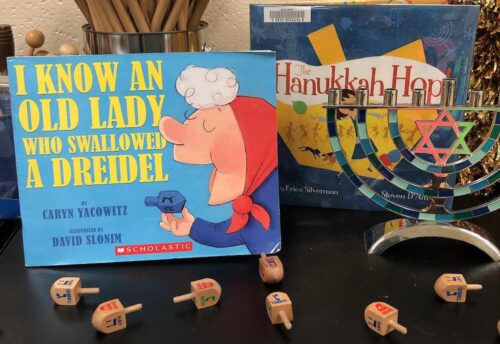
12 Comments